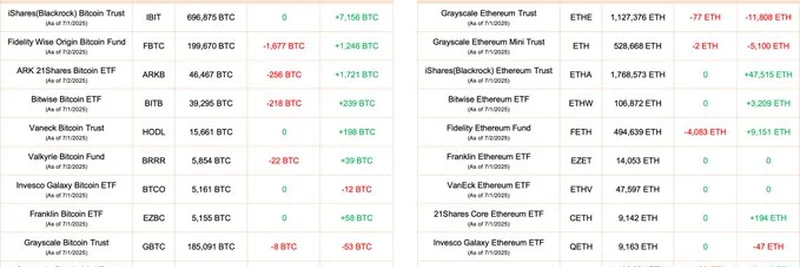If you’ve been keeping an eye on the crypto market, you’ve probably noticed some interesting shifts in the world of Bitcoin and Ethereum Exchange-Traded Funds (ETFs). On July 2, 2025, the team at Lookonchain dropped a detailed update that’s got everyone talking. This post breaks down the latest net flows and holdings for 10 Bitcoin ETFs and 9 Ethereum ETFs, giving us a snapshot of where the big players are putting their money—or pulling it out.
Bitcoin ETF Outflows Take Center Stage
The data reveals a net outflow of 2,180 BTC (roughly $234.93 million) across the 10 Bitcoin ETFs. That’s a red flag for some investors, but the picture varies by fund. Fidelity’s Wise Origin Bitcoin Fund (FBTC) saw the biggest hit, with 1,677 BTC ($180.69 million) flowing out. Despite this, Fidelity still holds an impressive 199,670 BTC, valued at $21.51 billion. Other funds like iShares (IBIT) and ARK 21Shares (ARKB) saw inflows of 7,156 BTC and 1,721 BTC respectively, showing a mixed bag of activity.
The total BTC holdings across these ETFs stand at 1,243,255 BTC ($133.95 billion), with a 7-day net inflow of 10,736 BTC ($1.16 billion). This suggests that while there’s some short-term selling pressure, the long-term trend might still be bullish for Bitcoin ETFs.
Ethereum ETFs See Similar Trends
Over on the Ethereum side, the story is similar but with its own twists. The 9 Ethereum ETFs recorded a net outflow of 4,162 ETH ($10.2 million). Fidelity’s Ethereum Fund (FETH) led the outflows with 4,083 ETH ($10 million), leaving it with 494,639 ETH ($1.21 billion). Meanwhile, funds like iShares (ETHA) and Bitwise (ETHW) saw modest inflows of 47,515 ETH and 3,209 ETH, respectively.
The total ETH holdings across these ETFs amount to 4,106,084 ETH ($10.08 billion), with a 7-day net inflow of 43,113 ETH ($105.63 million). This indicates that while there’s some profit-taking happening, the overall interest in Ethereum ETFs remains steady.
What’s Driving These Moves?
So, what’s behind these outflows? One theory floating around (as seen in replies to the Lookonchain post) is that institutions might be taking a “July cooldown”—rebalancing their portfolios after a busy period. Another possibility is that big players like Fidelity are adjusting their strategies, perhaps locking in gains from recent price surges. With Bitcoin hovering around $108,000, as noted by one user, this could just be “institutional churn” rather than a sign of panic.
A Closer Look at the Big Players
Fidelity’s massive holdings—199,670 BTC and 494,639 ETH—highlight its dominant position in the crypto ETF space. But how do these numbers stack up against other giants like BlackRock or Grayscale? While the data doesn’t give us a full breakdown, it’s clear that institutional ownership is a growing force. Some estimates suggest institutions, ETFs, and governments collectively hold over 2.2 million BTC, which is about 10% of the total supply. This trend could reshape how we think about crypto’s decentralized nature.
What This Means for Meme Token Enthusiasts
At Meme Insider, we’re all about keeping you in the loop on blockchain trends, even if your heart beats for meme tokens like Dogecoin or Shiba Inu. While Bitcoin and Ethereum ETFs might not directly impact meme coins, the broader market sentiment they reflect can spill over. If institutional money starts pulling back, it might create opportunities—or risks—for smaller altcoins. Keep an eye on these flows as a barometer for the market!
Final Thoughts
The July 2, 2025, update from Lookonchain offers a fascinating glimpse into the current state of Bitcoin and Ethereum ETFs. With significant outflows from Fidelity and mixed results across other funds, it’s a reminder that even the crypto market’s heavyweights are navigating choppy waters. Whether this is a temporary dip or a sign of bigger shifts, staying informed is key. What do you think—will these outflows signal a market correction, or are we just seeing a healthy rebalance? Drop your thoughts in the comments!


